2024届高考英语句子成分分析 简单句句型课件(29张PPT)
文档属性
| 名称 | 2024届高考英语句子成分分析 简单句句型课件(29张PPT) | 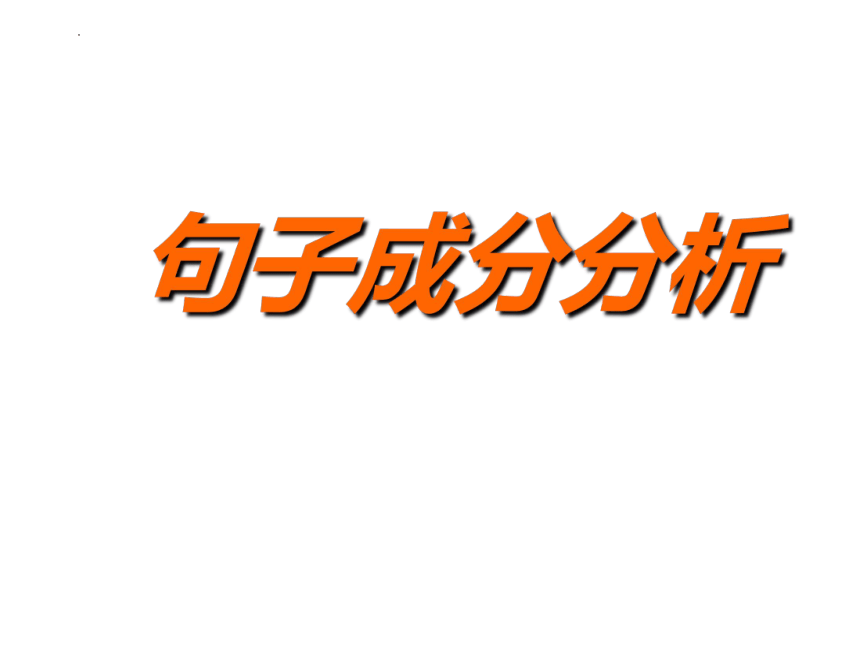 | |
| 格式 | pptx | ||
| 文件大小 | 418.8KB | ||
| 资源类型 | 教案 | ||
| 版本资源 | 通用版 | ||
| 科目 | 英语 | ||
| 更新时间 | 2023-10-11 12:29:52 | ||
图片预览

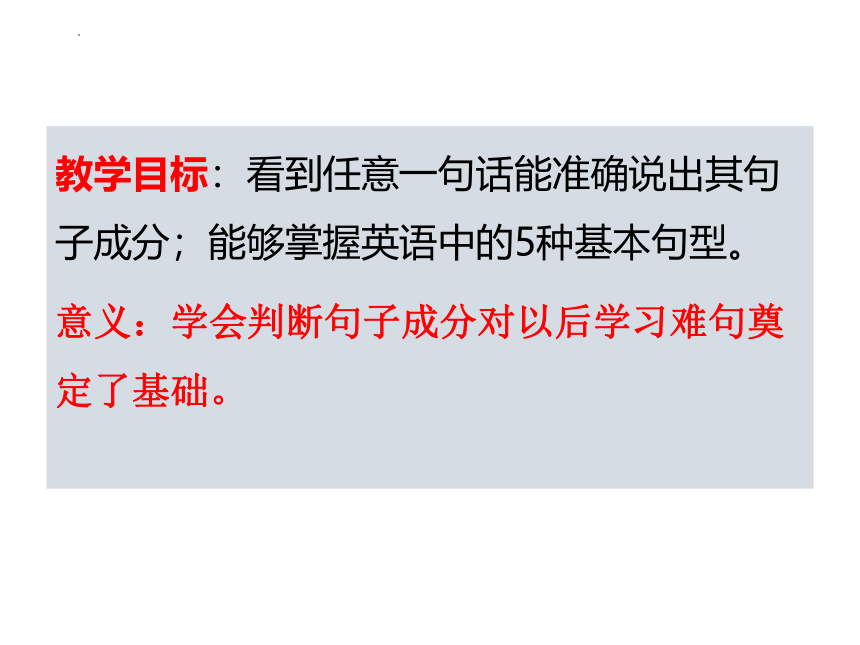
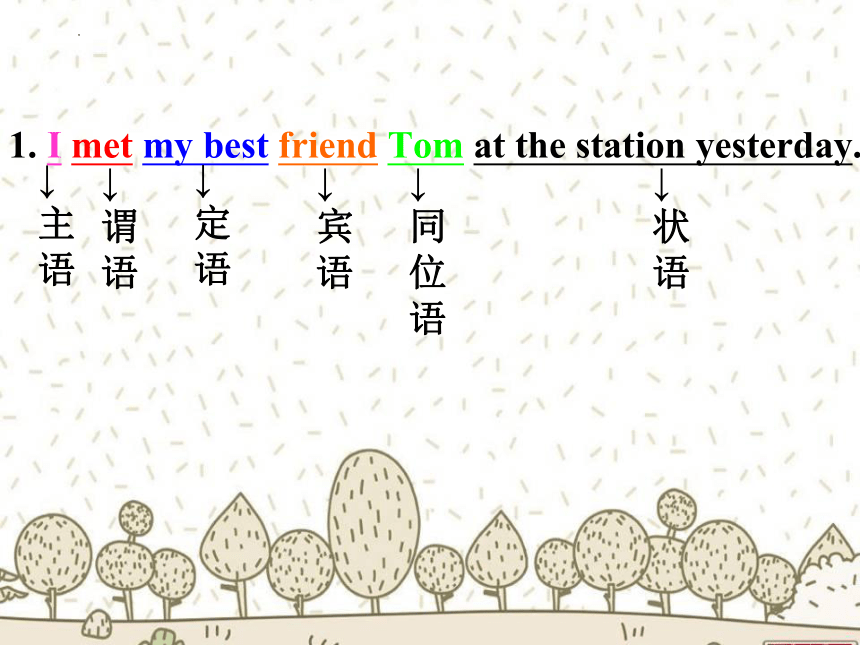
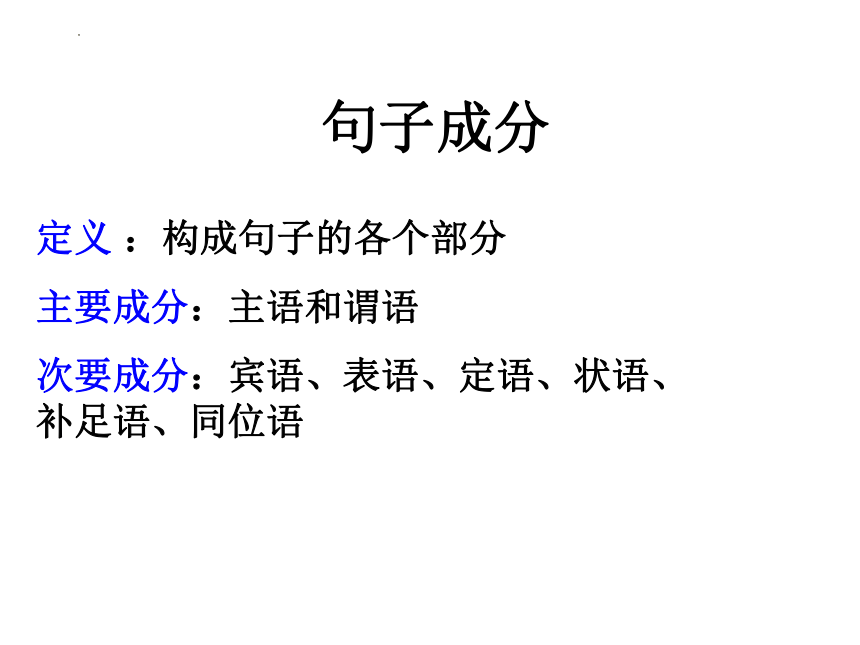
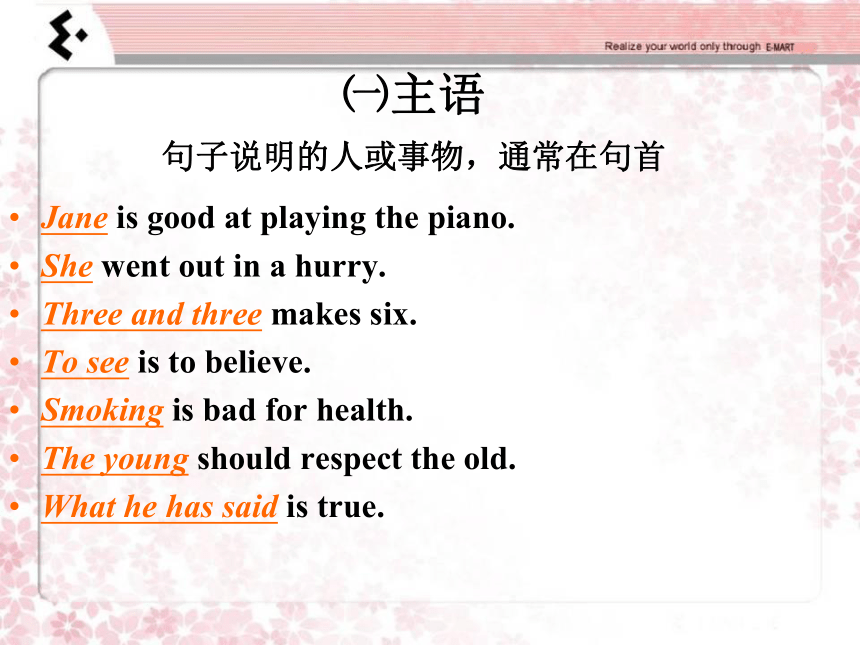
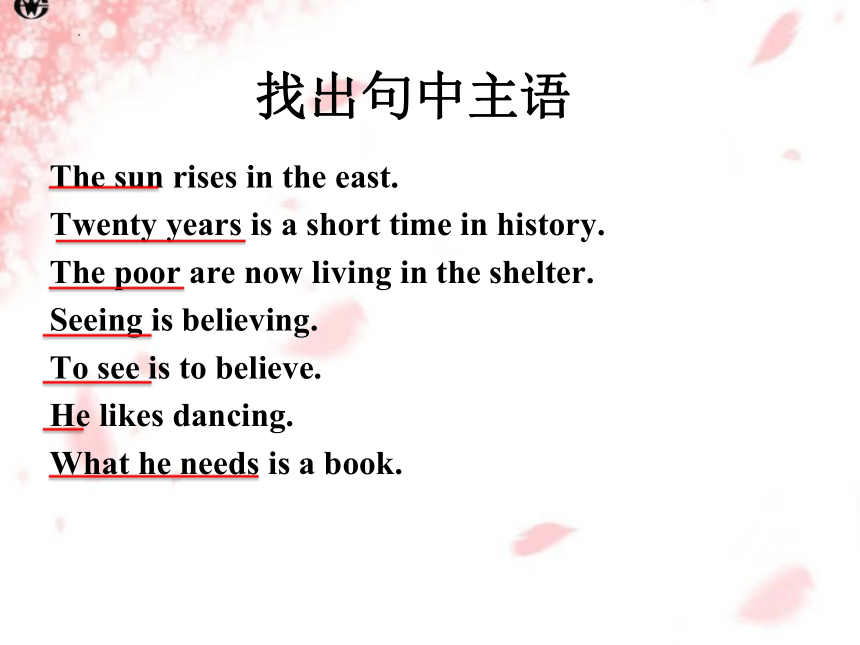

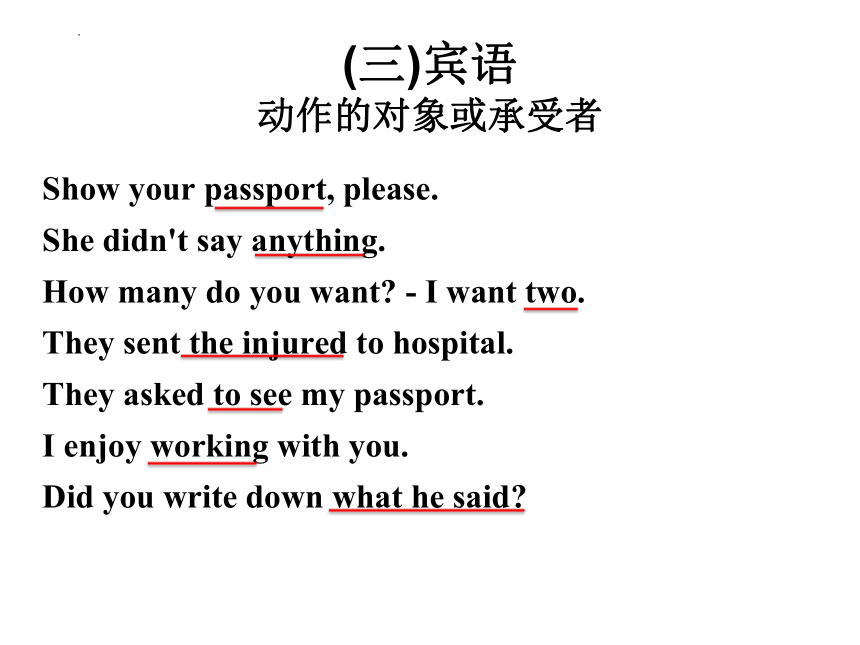
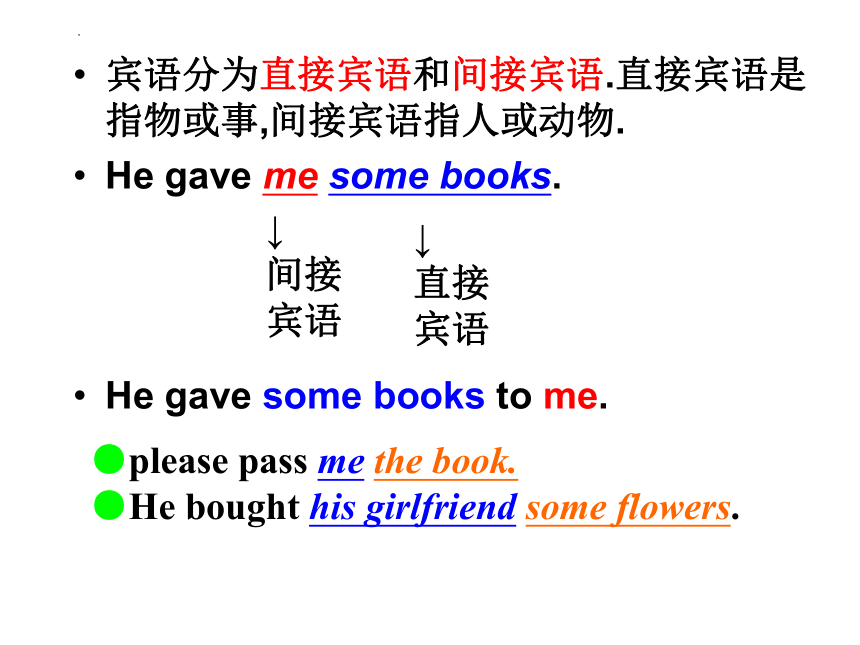
文档简介
(共29张PPT)
句子成分分析
句子成分分析
教学目标:看到任意一句话能准确说出其句子成分;能够掌握英语中的5种基本句型。
意义:学会判断句子成分对以后学习难句奠定了基础。
1. I met my best friend Tom at the station yesterday.
↓
主语
↓
谓
语
↓
定语
↓
宾
语
↓
同位语
↓
状
语
句子成分
定义 :构成句子的各个部分
主要成分:主语和谓语
次要成分:宾语、表语、定语、状语、补足语、同位语
㈠主语
句子说明的人或事物,通常在句首
Jane is good at playing the piano.
She went out in a hurry.
Three and three makes six.
To see is to believe.
Smoking is bad for health.
The young should respect the old.
What he has said is true.
找出句中主语
The sun rises in the east.
Twenty years is a short time in history.
The poor are now living in the shelter.
Seeing is believing.
To see is to believe.
He likes dancing.
What he needs is a book.
㈡谓语
说明主语的动作、状态和特征
简单谓语:由动词或动词词组组成
I saw the flag on the top of the hill
He looked after two orphans.
复合谓语:情态动词或助动词+动词;
He can speak English well.
She doesn’t seem to like dancing
复合谓语: 系表结构
His idea sounds resonable.
Show your passport, please.
She didn't say anything.
How many do you want - I want two.
They sent the injured to hospital.
They asked to see my passport.
I enjoy working with you.
Did you write down what he said
(三)宾语
动作的对象或承受者
宾语分为直接宾语和间接宾语.直接宾语是指物或事,间接宾语指人或动物.
He gave me some books.
He gave some books to me.
↓
间接
宾语
↓
直接
宾语
●please pass me the book.
●He bought his girlfriend some flowers.
(四)表语
表语主要用于表述主语的特征,状态,身份等。它位于连系动词后,构成系表结构。
连系动词
例:我是一个老师.
I am a teacher.
表语
例:这种水果尝起来味道很好.
This kind of fruit tastes very delicious.
表语
1.be动词(am, is, are, was, were)
3.感官动词(look, smell, sound, taste,feel…)
+表语
2.表状态变化的动词(get/become/turn/keep/remain/stay)
例:那个女孩变得非常担心.
The girl got worried.
表语
(五)定语
修饰或限制名词或代词的词、词组或从句
He is a clever boy.
His father works in a steel work.
There are 54students in our class.
Do you known betty’s sister
The swimming pool is beautiful.
There is a sleeping baby in bed.
His spoken language is good.
定语后置:
如果定语是由一个单词表示时,通常要前置。而由一个词组或一个句子表示时,通常则后置
The girl in red is his sister.
We have a lot of work to do.
The girl standing under the tree is his daughter.
Do you know the man who spoke just now
(六)状语
状语是啥?--来自妈妈的灵魂拷问
1. 干啥了?
--打架了
2. 在哪(打架)?
3. 啥时候(打架)?
4. 为什么要(打架)?
5.(打架)啥程度?
......
I fought with Peter fiercely this morning
in the classroom because he called me an idiot.
(六)状语
状语的功用:状语说明时间、地点、原因、目的、结果、条件、方式、程度、让步和伴随状况等。
I will be back in a while.
They are playing on the playground.
He was late because he got up late.
I waited to see you.
He got up so late that he missed the train.
Please call me if it is necessary.
He often went to school by bus.
This book is very interesting.
Although it was late, he went on working.
His parents died, leaving him an orphan.
补语
主语补足语:
宾语补足语:
补充说明主语的动作或状态
补充说明宾语的动作或状态
1.我又累又困,就去睡了。
Tired and sleepy, I went to bed.
2.我发现那本书很有趣。
I found that book very interesting.
主语补足语
宾语补足语
(七)补足语
同位语是指当两个同一事物的句子成分放在同等位置时,一个句子成分可被用来说明或解释另一个句子成分。
我们有两个孩子,一男一女.
We have two children, a boy and a girl.
那人是我的老师,他从来都不骑自行车.
The man, my teacher, never rides a bike.
(八)同位语
Exercises:分析句子结构
1)You are a student.
2)He felt happy today.
3)What you said made me happy.
4)Could you give me some advice on how to learn English well
5)After he finished his homework, he went away.
6)He likes pop music.
7)The sound sounds strange.
8)The food tastes good.
9)He gave me a book yesterday.
简单句的五种基本句型
一: 主+谓
二: 主+系+表
三: 主+谓+宾
四: 主+谓+间宾+直宾
五: 主+谓+宾+宾补
英语中的句子有三大类:简单句,并列句和复合句。
基本句型 一:主+谓
谓语:不及物动词(vi.)没有宾语, 形成主谓结构。
如: We come.
(不及物动词)
1. The sun rises.
2. Who cares
3. What he said does not matter.
4. They talked for half an hour.
5. The pen writes smoothly
基本句型二:主+系+表
1. This is a dictionary.
2. The dinner smells good.
3. He fell in love.
4. Everything looks different.
基本句型 三:主+谓+宾
此句型的特点是:谓语动词都是及物动词,必须
跟有一个宾语, 即动作的承受者, 才能使意思完整。
1. Who│knows│the answer
2. He │has refused│to help them.
3. He│enjoys│reading.
基本句型 四:主+谓+间宾+直宾
有些及物动词可以有两个宾语, e.g.
give/pass/bring/show。这两个宾语通常一个
指人(间接宾语); 一个指物(直接宾语)。
--Give me a cup of tea please.
--Give a cup of tea to me please.
give sb sth= give sth to sb
基本句型 五:主+谓+宾+宾补
此句型的特点是: 动词虽然是及物动词, 但是只跟一个
宾语还不能表达完整的意思, 必须加上一个补充成分
来补足宾语, 才能使意思完整。
宾语补足语: 位于宾语之后对宾语作出说明的成分。
We should keep the classroom clean.
You make me happy.
是由两个或两个以上并列而又独立的简单句构成。两个简单句常由并列连接词连在一起;但有时不用连接词,只在两个简单句之间用分号。
二. 基本结构:“简单句+并列连词+简单句”
并列句
一. 概念
It is late , so we must hurry.
It is late ;we must hurry.
He helps me______ I help him。
He_______ gave us a lot of advice,_______ helped us to study English.
Hurry up,_______you’ll be late.
_____Tom is coming_____ his sisters are (coming).
She looks very young, _____she is already in her 30's.
and
but also
not only
常用的连词有 and, so, but, however,
or(或者,否则), not only...but also...,
either...or( 不是……就是 ) 等。如:
or
Either
or
but
复合句
一.定义:由一个主句和一个或多个从句构成。
主句可以独立存在;
从句不能独立存在。
种类:有3大类。即状语从句,定语从句和名词性从句(主语,宾语,表语,同位语从句)。
When I got home from work yesterday,
(这是一句完整的话,但表达的意思不完整,不能独立存在)
I watched TV for an hour.(主句可以独立存在,意思完整)
I love to travel because I can meet a lot of interesting people
主
从
Even though the exam was quite difficult, all the students passed.
从
主
句子成分分析
句子成分分析
教学目标:看到任意一句话能准确说出其句子成分;能够掌握英语中的5种基本句型。
意义:学会判断句子成分对以后学习难句奠定了基础。
1. I met my best friend Tom at the station yesterday.
↓
主语
↓
谓
语
↓
定语
↓
宾
语
↓
同位语
↓
状
语
句子成分
定义 :构成句子的各个部分
主要成分:主语和谓语
次要成分:宾语、表语、定语、状语、补足语、同位语
㈠主语
句子说明的人或事物,通常在句首
Jane is good at playing the piano.
She went out in a hurry.
Three and three makes six.
To see is to believe.
Smoking is bad for health.
The young should respect the old.
What he has said is true.
找出句中主语
The sun rises in the east.
Twenty years is a short time in history.
The poor are now living in the shelter.
Seeing is believing.
To see is to believe.
He likes dancing.
What he needs is a book.
㈡谓语
说明主语的动作、状态和特征
简单谓语:由动词或动词词组组成
I saw the flag on the top of the hill
He looked after two orphans.
复合谓语:情态动词或助动词+动词;
He can speak English well.
She doesn’t seem to like dancing
复合谓语: 系表结构
His idea sounds resonable.
Show your passport, please.
She didn't say anything.
How many do you want - I want two.
They sent the injured to hospital.
They asked to see my passport.
I enjoy working with you.
Did you write down what he said
(三)宾语
动作的对象或承受者
宾语分为直接宾语和间接宾语.直接宾语是指物或事,间接宾语指人或动物.
He gave me some books.
He gave some books to me.
↓
间接
宾语
↓
直接
宾语
●please pass me the book.
●He bought his girlfriend some flowers.
(四)表语
表语主要用于表述主语的特征,状态,身份等。它位于连系动词后,构成系表结构。
连系动词
例:我是一个老师.
I am a teacher.
表语
例:这种水果尝起来味道很好.
This kind of fruit tastes very delicious.
表语
1.be动词(am, is, are, was, were)
3.感官动词(look, smell, sound, taste,feel…)
+表语
2.表状态变化的动词(get/become/turn/keep/remain/stay)
例:那个女孩变得非常担心.
The girl got worried.
表语
(五)定语
修饰或限制名词或代词的词、词组或从句
He is a clever boy.
His father works in a steel work.
There are 54students in our class.
Do you known betty’s sister
The swimming pool is beautiful.
There is a sleeping baby in bed.
His spoken language is good.
定语后置:
如果定语是由一个单词表示时,通常要前置。而由一个词组或一个句子表示时,通常则后置
The girl in red is his sister.
We have a lot of work to do.
The girl standing under the tree is his daughter.
Do you know the man who spoke just now
(六)状语
状语是啥?--来自妈妈的灵魂拷问
1. 干啥了?
--打架了
2. 在哪(打架)?
3. 啥时候(打架)?
4. 为什么要(打架)?
5.(打架)啥程度?
......
I fought with Peter fiercely this morning
in the classroom because he called me an idiot.
(六)状语
状语的功用:状语说明时间、地点、原因、目的、结果、条件、方式、程度、让步和伴随状况等。
I will be back in a while.
They are playing on the playground.
He was late because he got up late.
I waited to see you.
He got up so late that he missed the train.
Please call me if it is necessary.
He often went to school by bus.
This book is very interesting.
Although it was late, he went on working.
His parents died, leaving him an orphan.
补语
主语补足语:
宾语补足语:
补充说明主语的动作或状态
补充说明宾语的动作或状态
1.我又累又困,就去睡了。
Tired and sleepy, I went to bed.
2.我发现那本书很有趣。
I found that book very interesting.
主语补足语
宾语补足语
(七)补足语
同位语是指当两个同一事物的句子成分放在同等位置时,一个句子成分可被用来说明或解释另一个句子成分。
我们有两个孩子,一男一女.
We have two children, a boy and a girl.
那人是我的老师,他从来都不骑自行车.
The man, my teacher, never rides a bike.
(八)同位语
Exercises:分析句子结构
1)You are a student.
2)He felt happy today.
3)What you said made me happy.
4)Could you give me some advice on how to learn English well
5)After he finished his homework, he went away.
6)He likes pop music.
7)The sound sounds strange.
8)The food tastes good.
9)He gave me a book yesterday.
简单句的五种基本句型
一: 主+谓
二: 主+系+表
三: 主+谓+宾
四: 主+谓+间宾+直宾
五: 主+谓+宾+宾补
英语中的句子有三大类:简单句,并列句和复合句。
基本句型 一:主+谓
谓语:不及物动词(vi.)没有宾语, 形成主谓结构。
如: We come.
(不及物动词)
1. The sun rises.
2. Who cares
3. What he said does not matter.
4. They talked for half an hour.
5. The pen writes smoothly
基本句型二:主+系+表
1. This is a dictionary.
2. The dinner smells good.
3. He fell in love.
4. Everything looks different.
基本句型 三:主+谓+宾
此句型的特点是:谓语动词都是及物动词,必须
跟有一个宾语, 即动作的承受者, 才能使意思完整。
1. Who│knows│the answer
2. He │has refused│to help them.
3. He│enjoys│reading.
基本句型 四:主+谓+间宾+直宾
有些及物动词可以有两个宾语, e.g.
give/pass/bring/show。这两个宾语通常一个
指人(间接宾语); 一个指物(直接宾语)。
--Give me a cup of tea please.
--Give a cup of tea to me please.
give sb sth= give sth to sb
基本句型 五:主+谓+宾+宾补
此句型的特点是: 动词虽然是及物动词, 但是只跟一个
宾语还不能表达完整的意思, 必须加上一个补充成分
来补足宾语, 才能使意思完整。
宾语补足语: 位于宾语之后对宾语作出说明的成分。
We should keep the classroom clean.
You make me happy.
是由两个或两个以上并列而又独立的简单句构成。两个简单句常由并列连接词连在一起;但有时不用连接词,只在两个简单句之间用分号。
二. 基本结构:“简单句+并列连词+简单句”
并列句
一. 概念
It is late , so we must hurry.
It is late ;we must hurry.
He helps me______ I help him。
He_______ gave us a lot of advice,_______ helped us to study English.
Hurry up,_______you’ll be late.
_____Tom is coming_____ his sisters are (coming).
She looks very young, _____she is already in her 30's.
and
but also
not only
常用的连词有 and, so, but, however,
or(或者,否则), not only...but also...,
either...or( 不是……就是 ) 等。如:
or
Either
or
but
复合句
一.定义:由一个主句和一个或多个从句构成。
主句可以独立存在;
从句不能独立存在。
种类:有3大类。即状语从句,定语从句和名词性从句(主语,宾语,表语,同位语从句)。
When I got home from work yesterday,
(这是一句完整的话,但表达的意思不完整,不能独立存在)
I watched TV for an hour.(主句可以独立存在,意思完整)
I love to travel because I can meet a lot of interesting people
主
从
Even though the exam was quite difficult, all the students passed.
从
主
